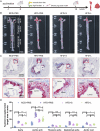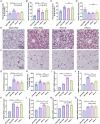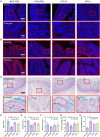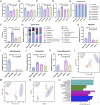Inulin alleviates atherosclerosis through improving lipid metabolism, inflammation, and gut microbiota in ApoE-knockout mice: the short-chain is more efficacious
- PMID: 39449970
- PMCID: PMC11499155
- DOI: 10.3389/fphar.2024.1445528
Inulin alleviates atherosclerosis through improving lipid metabolism, inflammation, and gut microbiota in ApoE-knockout mice: the short-chain is more efficacious
Abstract
Introduction: Atherosclerosis (AS) is considered the underlying cause of many diseases, particularly cardiovascular and cerebrovascular diseases. Inulin, a type of fructan, has shown potential in improving atherosclerosis, although there are conflicting findings. It is hypothesized that the polymerization degree of inulin may largely influence its therapeutic effectiveness. Therefore, this study aimed to investigate the effects and mechanisms of short-chain and long-chain inulin in AS.
Methods: ApoE-/- mice fed a high fat diet (HFD) were used to establish an atherosclerosis model. These mice received daily oral administration of either short-chain or long-chain inulin for 12 weeks. Plasma lipid metabolism-related indices were measured using biochemical analysis, and plasma immunological indices were analyzed via ELISA. The aorta, aortic root regions, liver tissue, adipose tissue, and colon tissue were examined through various staining techniques, including ORO staining, hematoxylin and eosin staining, Alcian blue staining, and immunofluorescent or immunohistochemical assays. Microbiome analysis was conducted in the cecal content.
Results: The results indicated that both short-chain and long-chain inulin substantially reduced the formation of atherosclerotic plaques. Inulin also improved plasma lipid concentrations and hepatic lipid metabolism, and partially alleviated both localized (atherosclerotic lesions) and systemic inflammation. Short-chain inulin was more effective than long-chain inulin in reducing atherosclerotic plaques formation, enhancing lipid metabolism and reducing inflammation. Additionally, both types of inulin showed similar effectiveness in enhancing intestinal epithelial barrier integrity, gut microbiota composition and functionality.
Conclusion: These findings suggest that inulin has a protective role against atherosclerosis by enhancing lipid metabolism, reducing inflammation, and improving intestinal barrier and gut microbiota. As a dietary intervention, short-chain inulin is more effective than long-chain inulin, offering clinical implications for using inulin as a therapeutic agent for atherosclerosis.
Keywords: atherosclerosis; gut microbiota; inflammation; intestinal barrier; inulin; lipid metabolism.
Copyright © 2024 Zhang, Zeng, Li, Huang, Zhang, Gong, Xiao, Chen, Chen, Qiu, Lei, Yan, Lang, Duan and Dong.
Conflict of interest statement
The authors declare that the research was conducted in the absence of any commercial or financial relationships that could be construed as a potential conflict of interest.
Figures





Similar articles
-
The effect and mechanism of inulin on atherosclerosis is mediated by the characteristic intestinal flora and metabolites.Coron Artery Dis. 2024 Sep 1;35(6):498-508. doi: 10.1097/MCA.0000000000001377. Epub 2024 May 17. Coron Artery Dis. 2024. PMID: 38767579
-
Gut microbiota and short chain fatty acids partially mediate the beneficial effects of inulin on metabolic disorders in obese ob/ob mice.J Food Biochem. 2022 May;46(5):e14063. doi: 10.1111/jfbc.14063. Epub 2022 Feb 7. J Food Biochem. 2022. PMID: 35128673
-
eIF6 deficiency regulates gut microbiota, decreases systemic inflammation, and alleviates atherosclerosis.mSystems. 2024 Oct 22;9(10):e0059524. doi: 10.1128/msystems.00595-24. Epub 2024 Sep 3. mSystems. 2024. PMID: 39225466 Free PMC article.
-
The prebiotic inulin modulates gut microbiota but does not ameliorate atherosclerosis in hypercholesterolemic APOE*3-Leiden.CETP mice.Sci Rep. 2018 Nov 8;8(1):16515. doi: 10.1038/s41598-018-34970-y. Sci Rep. 2018. PMID: 30409998 Free PMC article.
-
Dietary glycation compounds - implications for human health.Crit Rev Toxicol. 2024 Sep;54(8):485-617. doi: 10.1080/10408444.2024.2362985. Epub 2024 Aug 16. Crit Rev Toxicol. 2024. PMID: 39150724
Cited by
-
Effect of fiber-modified kombucha tea on gut microbiota in healthy population: A randomized controlled trial (RCT).Curr Res Food Sci. 2025 Jun 26;11:101130. doi: 10.1016/j.crfs.2025.101130. eCollection 2025. Curr Res Food Sci. 2025. PMID: 40689297 Free PMC article.
-
The role of plant-based dietary compounds in gut microbiota modulation in inflammatory bowel disease.Front Nutr. 2025 May 30;12:1606289. doi: 10.3389/fnut.2025.1606289. eCollection 2025. Front Nutr. 2025. PMID: 40521353 Free PMC article. Review.
References
-
- Amato A., Caldara G., Nuzzo D., Baldassano S., Picone P., Rizzo M., et al. (2017). NAFLD and atherosclerosis are prevented by a natural dietary supplement containing curcumin, silymarin, guggul, chlorogenic acid and inulin in mice fed a high-fat diet. Nutrients 9 (5), 492. 10.3390/nu9050492 - DOI - PMC - PubMed
-
- Beisner J., Filipe Rosa L., Kaden-Volynets V., Stolzer I., Günther C., Bischoff S. C. (2021). Prebiotic inulin and sodium butyrate attenuate obesity-induced intestinal barrier dysfunction by induction of antimicrobial peptides. Front. Immunol. 12, 678360. 10.3389/fimmu.2021.678360 - DOI - PMC - PubMed
-
- Birkeland E., Gharagozlian S., Birkeland K. I., Valeur J., Mage I., Rud I., et al. (2020). Prebiotic effect of inulin-type fructans on faecal microbiota and short-chain fatty acids in type 2 diabetes: a randomised controlled trial. Eur. J. Nutr. 59 (7), 3325–3338. 10.1007/s00394-020-02282-5 - DOI - PMC - PubMed
LinkOut - more resources
Full Text Sources
Research Materials
Miscellaneous

